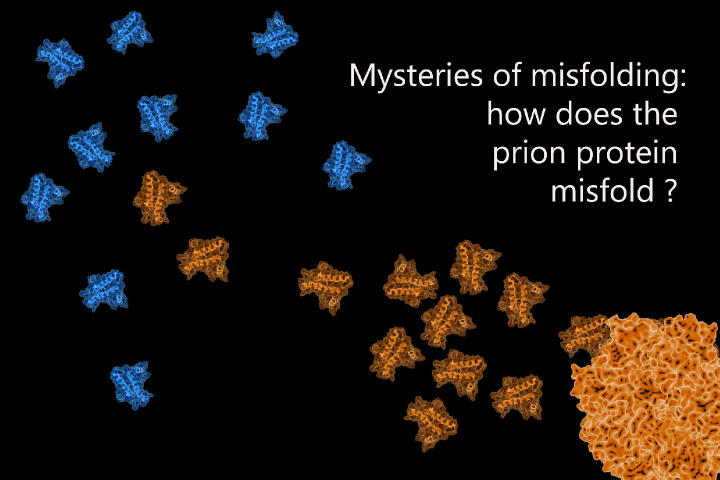Prions are strange, even by the standards of the biological world which regularly throws up bizarre creations. They are the agents that cause mad cow disease in cattle, scrapie in sheep, Creutzfeldt- Jakob disease (the equivalent of mad-cow in humans) and fatal familial insomnia. The term prion was coined from the words “protein” and “infection” to reflect its unique nature – an infectious protein, which does not require the all-important DNA or RNA molecules to copy and transmit biological information.
Prions are misfolded forms of regular cell proteins with a distinctive ability to convert their normally folded counterparts into more prions. If prions are deviant forms of normal proteins, sheer curiosity prompts one to ask – how are they formed? What causes these normal proteins to contort themselves into the prion form? Scientists Jogender Singh and Jayant Udgaonkar from the National Centre for Biological Sciences (NCBS, Bangalore) have a partial answer to this. Their work on the prion protein demonstrates that certain genetic mutations can destabilise the structure of the proteins and set it onto a “misfold path” leading to the aberrant 3-D conformation of a prion.
As with all proteins, prions are made of amino acids (the fundamental building blocks of proteins) that are chemically bonded to each other in a specific sequence. A simple analogy can liken them to beads of different sizes and shapes strung together. The ability to fold into a 3-dimensional structure such as a helix or a sheet depends on its constituent amino acids – much like how the physical and chemical attributes of the component beads allow the arrangement of such a string into a 3-D shape. Changing a single amino acid could drastically alter the folded form of a protein, just as changing a bead could affect the final form of a bead sculpture. Singh’s and Udgaonkar’s work shows that such single amino acid mutations in particular stretches of the normal protein sequence can spontaneously initiate misfolding into a prion.
The study utilised one of the first known prion proteins – simply dubbed “Prion Protein” or PrP – as a model to examine how naturally occurring amino acid mutations could disrupt normal protein structure to induce it to misfold. “We know that genetic or familial instances of prion diseases could be caused by single amino acid mutations in prion proteins. What we have tried to understand here is the mechanism of misfolding of the prion protein by studying the effects of familial mutations on the structure of the protein”, says Dr. Singh, the lead author in this investigation. The answer lies in a section of PrP named “α-helix 1” – a segment that is shaped like a helix. When this structure and an adjacent loop are destabilised due to pathogenic mutations, misfolding is facilitated in other parts of the prion protein, and the rates of PrP’s normal-to-prion conversion are increased. The instabilities cause the formation of flat sheet-like structures which further drive the transition of other helices within the protein into sheets.
“What is even more interesting is that none of the mutations we have studied are actually in the α-helix 1 region; but all of them destabilise this region”, says Dr. Singh. The results of this work also showed that the extent of misfolding in a mutant PrP was highly correlated with the extent of destabilisation in the α-helix 1 region wrought by the mutation.
The misfolded proteins now stick together to form spherical “oligomers”, whose subunits consist of the misfolded prions. The accumulation of such protein oligomers in nerve cells is the main cause of neuro-degenerative symptoms and ultimately, death, in patients with prion diseases. Research on other neurodegenerative disorders such as Parkinson’s and Alzheimer’s have noted a striking similarity between the toxic protein clumps (called amyloid plaques) within neurons found in these conditions and the prion oligomers in prion diseases. Therefore, these conditions are also increasingly being thought of as prion diseases or “prion phenomena”.
The research highlighted in this article elucidates the initiating steps of prion formation. This knowledge is of immense practical value as arresting these steps can stall the progress of prion formation and hence the disease it causes. Intriguingly, in another study Singh and colleagues showed that specific stabilization of the prion protein by mutation could completely inhibit its misfolding. Current therapies for prion diseases have taken the form of antibodies and other molecules that stabilise the helical structures in normal forms of potential prion proteins. These anti-prion drugs are highly potent in blocking further prion formation – they offer hope in not only surviving prion diseases, but may also prove therapeutic for Alzheimer’s or Parkinson’s.
About the study:
The paper appeared in the journal Angenwandte Chemie on 8th May 2015, and can be accessed here.










0 Comments